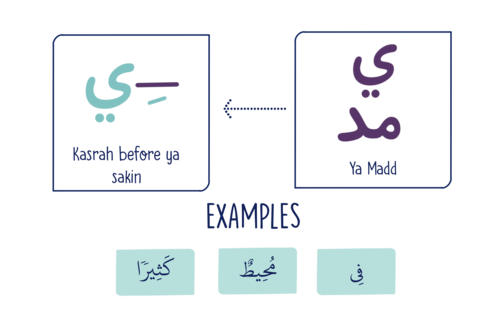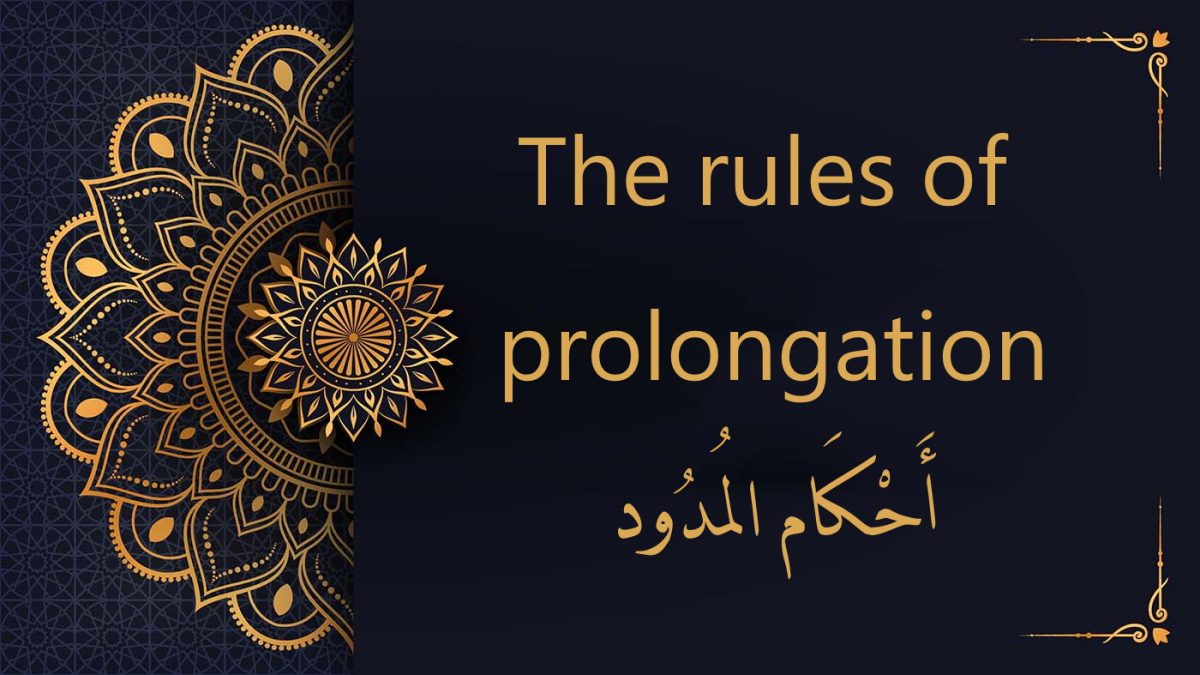Tajweed Madd Rules
Table of Contents
ToggleOne of the main benefits of learning the Qur’an with Tajweed is mentioned in the hadith of the Prophet “Those who can recite the Qur’an accurately and precisely will attain the highest ranks in Heaven” because the Holy Qur’an is the only book that its recitation is considered a form of worship with great reward. No other book or letter fits this description.
It is expected of every Muslim to read the Qur’an correctly as much as he can and in the correct way that was revealed to our Holy Prophet. Moving on to the article, we will study all the rules of Mim Sakina to the best of our ability and explore types of Madd in Tajweed.
Allah The Almighty said:
“And recite the Qur’an with a chant”, i.e., do not rush to read the Qur’an, but rather read it slowly and clearly while reflecting on the meanings.
Messenger of Allah (PBUH) said:
“The one who is proficient with the Qur’an will be with the noble and righteous scribes (the angels), and the one who reads it and stumbles over it, finding it difficult, will have two rewards.”
Ibn Al-Jazari also “Most Famous Tajweed Scholar” said:
“The practical application of Tajweed is without doubt compulsory. Who does not read the Quran correctly is a sinner”.
Before we shed light on Madd Rules and dive into the practice comprehension of its rules, it is also recommended to read the Great Benefits Of Learning Tajweed Quran, as they are also very important an crucial.
We also need to explain why these conditions are known and applied while reciting the Holy Quran. As we know, reading the Qur’an well means reading it correctly according to the rules of Tajweed. Hence, it is important for reciters to know the Madd Quran concepts.
God Almighty revealed the Noble Qur’an to our Prophet Muhammad in this form (Tajweed) and commanded him to recite its verses, meditate on their meanings, understand their meanings, and beautify their recitation to be different and distinct from other textual readings.
Hence, Learning Tajweed Rules, including Madd Letters, a priority and giving it its dues effort and time is of great importance. Also, understanding our responsibilities so that we can receive his mercy is of our greatest duties.
Before we clarify the Rules Of Madd, check this inspiring article to know How To Learn Tajweed Online and apply its rules when reciting the Holy Quran.
Join thousands of Muslim Families who love learning Quran, Arabic and Islamic Studies from the comfort of their Homes.
Learn Quran, Arabic & Islamic Online
Join Best Online Tajweed Course
Definition Of Madd
Tajweed rules Madd can be better understood in light of its linguistic meaning, which is to increase or lengthen. God Almighty says in the Holy Qur’an: (وَنَمُدُّ لَه) in which the word “madd” in Arabic means that God will extend and add to their punishment. Hence, Madd in Tajweed refers to the stretching or extension of sounds of one of the 3 Madd letters.
What Is Madd In Quran
Madd means to stretch a sound and there are 3 Madd letters which are (ا – و – ي). When there is a Damma before wow sakin we stretach it for two counts and it is called wow Madd. When there is a Fatha before alif we stretch it for two counts and it is called Alif Madd.
Types Of Madd Letters
The meaning of Madd Badal in the Arabic language is when these two hamzas come in the same word, and the second with a sukoon sign, respectively, and it is called Madd Badal to convert the second hamza into a Madd letter in the movement of the first hamza.
The reason for this rule is the difficulty in pronouncing that occurs when two hamzas are consecutive (the second hamza has a Sukoon). After you look at the rule and its pronunciation, you may realize that ever since you started reading the Quran you have been applying this rule without realizing it. lets take a look!
Types Of Madd In Quran
There are two different types of Madd in Quran:
- Madd Asli/Tabi’y or Natural Madd.
- Madd Fare’e or Secondary Madd.
Arabic Madd Letters Rules
Before we expound on Madd rules in Tajweed, what are the 3 Madd letters? we will mention the 3 letters of Madd (ا , و , ي) that are found in the word: (نُوحِيهَا). By carefully examining this word, it is clear that the 3 Madd letters need to fulfill two conditions; firstly, they need to be without Fatha, Dummah or Kasrah and secondly, they need to be preceded by on of the 3 Harakah that is homogenous with the letter. This means that the vowel alif (ا) must be preceded by Fathah, the vowel yaa (ي) by Kasrah and the vowel waw (و) by Dammah.
- If Madd letter is Alif (ا), the letter before must have a fathah sign, and Alif itself remains silent without any vowel.
- If Madd letter is Waw (و), the letter before must have a dammah, and Waaw remains silent without any vowel.
- If Madd letter is Yaa (ي), the letter before must have a kasrah, and the Yaa itself remains silent without any vowel.
Types Of Madd In Arabic
There are 2 types of Madd Arabic:
- First type of Madd in Arabic is مد أصلي (طبيعي)
- First type of Madd in Arabic is مد فرعي (ثانوي)
You May Like To Read
10 Benefits Of Memorizing Quran
10 Benefits Of Learning Quran Online
Recommended Courses
Madd Tabee Examples
The first type, Natural Madd, gets its name from the fact that it is an integral part of the presence of the letter and does not depend on the presence of Hamzah (-) or Sukoon (ْ). This can be seen in the difference between these two words: سَجَد – سَاجِد, where alif cannot exist in (سَاجد) without the presence of a natural substance and its absence in (سَجَدَ) is completely different from the structure and meaning of the word. Even in length, Madd Asli is a natural as it only stretches for 2 beats or movements.
Madd Asli Examples
(هَلْ أَتَاكَ حَدِيثُ مُوسَىٰ)- (الناس – أفواجا)
Madd Asli can also be found in the letters of mnemonic: (حي طهر) at the beginning of certain surahs of the Qur’an as in:
- حم (1)
- طسم (1)
- طه (1)
In these verses, the Madd in the letters (حـ- طـ) is considered Natural Madd and is only lengthened for 2 counts.
1- Madd Al Iwad: compensated prolongation, occurs only at the end of a word that has tanween fat-h.
Madd Al Iwad Examples
(عليمًا – حكيمًا – خبيرًا)
2- One type of Madd that falls under Madd Asli category is “Lesser Connecting Madd” “مد صلة” which is associated with the use of the Arabic third-person masculine pronoun (هاء). This is one of the types of tide in the Qur’an that occurs when this pronoun that is not part of the word form has a duma or kasra but is not followed by a hamza or Sukoon – in the case of Sukoon. Some examples of this kind are:
Mad Sila Examples
(حكماً من أهلهِ وحكما من أهلها)- (فاعلم أنه لا إله إلا الله)- (كمن زيّن لهُ سوء عمله)
3- Another type of Madd that belongs to Natural Madd is “Substitute Madd” “مد بدل”. When the word ends with Alif and Tanween in case of pausing by the reader, this Alif should be stretched for two counts. These words provide some examples:
Madd Al Badal Examples
﴾ هُدًى ﴾ – ﴿ سُوًى ﴾ – ﴿ أَحَدًا ﴿
Here’s a quick recap of the points mentioned about Natural Madd:
Types Of Madd Faree
Therefore, Madd Far’ee is divided into two groups:
- Madd Faree due to Hamza
- Madd Faree due to Sukoon
Madd Faree examples
Meanwhile, Secondary Madd or Madd Far’ee is the elongation of vowels but it is dependent on the presence of Hamza or Sukoon. These are some Madd Far’ee examples:
(إلا أن يشاء الله) – (ربّ اجعل لي ءاية)
Madd Faree Due To Hamza
Attached Madd (Madd Muttasil): this type of Madd occurs when the Madd letter is followed by Hamza within a word. It has to be stretched or elongated for 4,5 or 6 counts. Some examples of this Madd in Qur’an are:
(وقالوا لو شاء الرحمن ما عبدناهم)- (فبأي آلاء ربكما تكذبان)
Madd Munfasil Examples
Separate Madd (Madd Munfasil): a similar condition is present with this type of Madd but the main difference is that the Madd letter and the Hamza are in separate words instead of being in one. It is permissible for the reader to shorten the vowel for 2 counts or lengthen it for four or five counts. Examine the Madd in the following verses:
(إنا أعطيناك الكوثر)- (واعلموا أن فيكم رسول الله)- (فآمنت طائفة من بني إسرائيل وكفرت طائفة)
Take a minute and test yourself on recognizing Madd Muttasil and Madd Monfasil in the following verse from Qur’an:
(إن هي إلا أسماء سميتموها أنتم وآباؤكم ما أنزل الله بها من سلطان)
Madd Badal Examples
Exchange Madd (Madd Badal): unlike the previous types of Madd Far’ee, the exchange Madd is found in words where the Hamza precedes the Madd letter and in this case the Madd is lengthened for 2 counts. Some examples of this Madd in Qur’an include:
(ماء غير ءاسن) (أُورثوا الكتاب) (وإيتاء الزكاة)
Greater Connecting Madd: much like the Lesser Connecting Madd, the Greater Connecting Madd also occurs when the masculine pronoun of third person singular, with the aforementioned conditions, comes at the end of a word and the following word starts with Hamza. The reader is allowed to lengthen this Madd for 2 or 4 counts as in:
(اسمه أحمد) – (ربه أحدا)
Madd Faree Due To Sukoon
Madd Arid Lissukun Examples
This type of Madd Far’ee is the result of the presence of two letters within a word, the first one is a Madd letter and the other is a letter with any Harakah on it but due to pausing, this Harakah turns into a Sukoon. This is found in verses from the Qur’an like:
(الرحمــن الرحيم)– (إن في ذلك لآيات لقوم يؤمنون)
In such cases, it is permissible to lengthen it for 2, 4 or 6 counts. However, if the reader doesn’t stop on it, the letter is only stretched for two counts as a natural Madd.
Madd Lazim Examples
With Madd Lazim or Compulsory Madd, the Sukoon that follows the Madd letter is original as opposed to the Sukoon with Madd ‘Arid lil-Sukoon in which the Sukoon exists only in case of stopping or pausing.
Types of Madd E Lazim
There are two types of Madd Lazim; one occurs within a word (kalimi) and the other occurs within a letter (harfi). Each type is divided into heavy Madd and light Madd and the length of each is measured by 6 counts.
1- Kalimi Muthaqqal (heavy): The first type which occurs within a word is a compulsory Madd that is the outcome of the following combination:
Madd Letter+ a saakin letter with shaddah on it.
The following verse of the Qur’an includes two Madd Lazims (with alif and wow) in which the Madd letter is followed by a saakin letter with shaddah within one word:
Madd E Lazim Examples
(قال أتحاجوني في الله وقد هدانِ)
2- Kalimi Mukhaffaf (light): the second type is caused by a similar combination but it differs that the saakin letter doesn’t have shaddah on it
Madd Letter+ a saakin letter without shaddah on it.
The word (آلآن) in this verse illustrates the aforementioned Tajweed Madd rule:
(أثم إذا ما وقع آمنتم به آلآن وقد كنتم به تستعجلون)
If you look closely, you will find that both words (آمنتم) and (آلآن) have what seems to be a similar structure but the key difference between them is that in (آمنتم), the Madd letter occurred after hamza and is not followed by Sukoon so it is a case of Madd Badal while in (آلآن) the Madd letter occurred before a saakin letter without shaddah on it which is Madd Kalimi Mukhaffaf.
3- Harfi Muthaqqal: the third type is spotted in the letters that are at the beginning of certain surahs. These letters are grouped in the mnemonic (كم عسل نقص) and as each letter is read as a three-letter word, this type of Madd only occurs when the last letter of the three is originally saakin. This letter is merged into the following letter as in:
﴾ الم ﴿
Here, the first letter (لام) ends with the same letter that begins the next one (ميم); thus, they are merged and the Madd letter is stretched for 6 counts.
4- Harfi Mukhaffaf: it is also in letters that begin some surahs of the Qur’an but it is distinguishable from the Harfi Muthaqqal by observing the letter that follows one of the following (كم عسل نقص) but it is not merged into the next letter. Some examples of this Madd rule are:
﴾ الر ﴾ ﴿ ق ﴾ ﴿ يس ﴿
In summary, the other type of Madd Far’ee that occurs due to Sukoon has two kinds where the Sukoon is an original part of the word in one unlike the other. In the verse (فإذا جاءت الصاخّة), the Madd letter is followed by a saakin letter that has shaddah which is Madd Kalimi Muthaqqal, a type of Madd Lazim. On the other hand, the verse (الذي هم فيه مختلفون) exhibits another kind of Madd Far’ee where the Sukoon is not an essential part of the word form, rather it only occurs in the case of pausing. This is Madd Arid Lil-sukoon. After knowing types of madd and examples, reciter can improve their recitation to a great extent.
Final Words
Madd is a very important rule of intonation because it plays a vital role in understanding the meanings of Quranic verses. Therefore, it is necessary to know the correct way to recite the verses and to understand the different types of midad in the Qur’an and their applications.
We at Mishkat Academy offer online courses to help our Muslim brothers and sisters improve their Quran recitation and God’s satisfaction. Our qualified teachers teach the Quran in the most effective and affordable way, enabling students to recite the verses with the correct pronunciation.
So, to understand the types of Madd and to become well acquainted with its application, join our online Tajweed classes today. To help you more on your journey to learn the Qur’an and Tajweed through the courses that both children and adults need to learn the Book of God.
FAQs
How many Madd in Quran
There are three letters of Madd, which are ا – و – ى. There are 9 different types of madd, with two further splitting into five segments, therefore making the total of 13.
Madd Leen examples in Quran
Madd e Leen: easy/eased prolongation only occurs when the reciter is stopping recitation after the word containing the madd, eg. for a breath, or at the end of an ayah, etc. Madd e Leen occurs when a waaw saakinah ( وْ ) or a yaa saakinah ( يْ ) are preceded by a letter with the fat-h diacritic ( ــَـ).
Madd letters Tajweed
Madd in Tajweed comes with three letters (ا , و , ي) and they are collected in the Arabic word نُوحِيهَا. These letters must be silent without any vowel on them, but the letter which appears before the letter of Madd must not be hamza.
How many Madd in Quran
One of the largest sections of Tajweed is Ahkaam Al-Madd. There are 9 different types of madd, with two further splitting into five segments, therefore making the total of 13.
Arabic Madd rules
Madd means to stretch a sound and there are three madd letters which are ا, و and ي. When there is a damma before wow sakin we stretach it for two counts and it is called wow madd. When there is a fatha before alif we stretch it for two counts and it is called alif madad.
What is Madd in Arabic
“Madd” denotes “prolongation” or “extension” in Arabic. It is a grammatical term for the stretching of a vowel sound in some words. In the Arabic language, for example, the letter “a” is frequently pronounced as “aa” in specific contexts, such as when it is followed by a “sukoon” (indicator of a stop or cessation) in the word, which is known as Madd.
Types of Madd letters in Arabic
There are three letters of Madd, which are ا – و – ى. These letters prolongate of a previous vowel to the measure of two vowels (2 counts), which is equal to the measure of one alif .
Haroof e Madd examples
Madd Tajweed rules
What are the 2 types of madd? The two main madd types are: Madd Asli/Tabi’y (Natural Madd) Madd Far’ee (Secondary Madd). Al-Madd in Tajweed comes with three letters (ا , و , ي) and they are collected in the Arabic word نُوحِيهَا.
Types of Tajweed
Many types of Tajweed include:
- Imala
- Idghaam
- Ikhfaa
- Tajwees madd rules
- Qalqalah
- Tafkheem and Tarqeeq
Madd wajib muttasil examples
Madd Waajib Mutasil: is the obligatory prolongation of Maad rules. It is prolonged for either four or five counts (your choice of either). If you choose to prolong for four counts, then this must remain consistent throughout your recitation. Likewise is if you chose to prolong for five counts.
Madd jaiz munfasil examples
Al-Madd Al-Jaa’ez Al-Munfasil: Permissible prolongation, occurs when a word ends with a harf madd (ا or ي or و) and is followed by a word that begins with hamza (ء). The name here has come about because of it’s rule. Madd means to prolong. Jaa’ez means permissible. Munfasil means detached/separated.
Alif Madd examples
When there is a damma before wow sakin we stretach it for two counts and it is called wow madd.




























